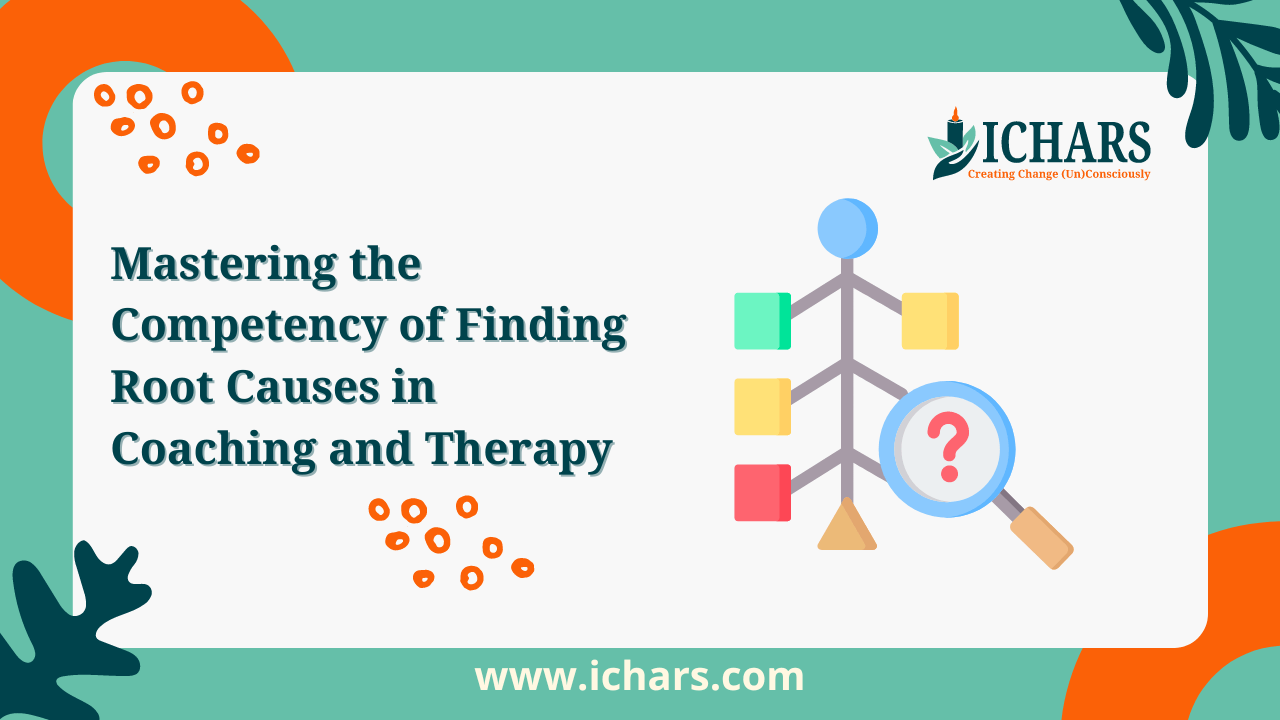Have you ever wondered why some clients seem stuck despite your best efforts? Or why certain behaviours and emotions persist even after addressing surface-level issues?
The answer often lies in uncovering the root causes of their challenges. Without identifying these deep-seated issues, such as secondary gains, entrenched beliefs, client identity, and past experiences, meaningful and lasting change can remain elusive.
This article delves into the competency of Finding Root Cause, exploring its importance and providing practical strategies for practitioners to enhance their skills in guiding clients toward self-discovery and transformation.
Note that coaches should not work with clients dealing with intense negative emotions, psychological disorders, or those needing to explore deeper past experiences – such cases should be handled by qualified psychologists.
Grasping the Depths: What is ‘Finding Root Cause’?
This competency goes beyond addressing surface-level symptoms to uncover the underlying factors contributing to a client’s current situation. This involves exploring the depths of a client’s psyche to identify hidden influences such as secondary gains, entrenched beliefs, sense of identity, and the impact of past experiences.
To effectively understand the root cause, practitioners must:

- Recognize the complex interplay between a client’s thoughts, feelings, and behaviours.
- Discern how secondary gains might be maintaining current issues, despite apparent disadvantages.
- Identify core beliefs and values that shape the client’s perception and experience of the world.
- Understand how a client’s sense of self or identity may influence their choices and actions.
- Consider the weight of past experiences, acknowledging how they may imprint on current behaviours and attitudes.
A comprehensive grasp of these domains enables a coach or therapist to tailor interventions that address issues at their origin, facilitating profound and lasting change.
Building Competence: How to Develop Finding Root Cause Skills
Unearthing the root cause within a client’s narrative requires a refined set of skills. Here are some strategic approaches for practitioners to enhance their competency in this area:

- Educational Foundation: Build a solid educational foundation in psychology, understanding how various factors like personality, learning, memory, and emotions intertwine to influence behaviour.
- Active Listening and Observation: Sharpen your active listening and observation skills. The nuances in a client’s stories or behaviours often hold clues to underlying issues.
- Questioning Techniques: Develop your ability to ask insightful and probing questions that encourage clients to think critically and reflect on deeper reasons behind their actions and beliefs.
- Assessment Tools: Familiarize yourself with psychological assessment tools that can help pinpoint underlying issues contributing to a client’s current concerns.
- Supervised Practice: Engage in supervision or mentorship where you can practice and discuss finding root causes with experienced professionals, gaining insights from their expertise.
- Continuous Learning: Stay abreast of new research and theories that can provide fresh perspectives on identifying foundational issues.
- Self-reflection: Cultivate self-reflection to recognize your biases and ensure they do not cloud your judgment in uncovering a client’s root cause.
By systematically developing these skills, coaches and therapists can become adept at discerning the often-subtle core issues that drive client distress or stagnation.
Practical Integration: Applying Finding Root Cause in Sessions
Effectively applying the skill of identifying root causes in coaching and therapy sessions can significantly enhance the support a practitioner offers. Here are practical ways to integrate this competency into your practice:
- Integrate Throughout the Process: Treat the identification of root causes as an ongoing process, not a one-time task. Integrate it into the narratives that unfold during each session.
- Create a Trusting Environment: Foster a safe and confidential space where clients feel comfortable sharing personal and often sensitive information.
- Use Probing Questions Strategically: Employ strategic questioning to gently guide clients toward self-examination and discovery of underlying issues.
- Case Formulation: Piece together information gathered from sessions into a coherent case formulation that links symptoms to deeper underlying causes.
- Monitoring Changes: Observe changes in clients’ behaviours or emotional states as potential indicators of root causes becoming more apparent.
- Review and Reflect: Regularly review your case notes and reflect on the ongoing sessions to ensure no root cause clues are missed or misinterpreted.
- Client Collaboration: Involve clients actively in the process, encouraging them to reflect on and contribute to the understanding of their own experiences.
Skillful application of these strategies in root cause identification can lead to deeper insights and more targeted interventions, paving the way for substantial and meaningful change.
Framework Insights: Cognitive Hypnotic Coaching and Psychotherapy Approach
The Cognitive Hypnotic Coaching and Psychotherapy (CHCP) framework enhances the competency of finding root causes by incorporating a synergistic mix of therapeutic modalities designed to delve into the client’s subconscious drivers. Here’s how CHCP advances this critical skill:

- Subconscious Communication: CHCP techniques facilitate communication with the subconscious mind, where many root causes may reside, through the use of suggestive language and imagery.
- Behavioural Pattern Recognition: Practitioners are trained to recognize recurring behavioural patterns that hint at underlying beliefs or past experiences, providing clues to the root cause.
- Hypno-Diagnostic Tools: Hypnosis is utilized as a diagnostic tool within the CHCP framework, uncovering hidden memories or suppressed emotions that might be influencing the client’s current concerns.
- Reframing and Cognitive Techniques: The ability to reframe client narratives and challenge cognitive distortions aids in revealing and altering foundational beliefs.
- Integration of Therapeutic Modalities: CHCP combines principles from various therapeutic models, providing a holistic approach to uncovering and addressing the root cause.
- Solution-Focused Approach: While the focus is on root causes, CHCP also emphasizes working towards solutions, ensuring that the identification process directly informs actionable strategies for change.
By utilizing the CHCP framework, coaches and therapists are equipped with a robust methodology for effectively detecting and understanding the foundational issues that impact their clients’ lives.
Navigating Complexities: Overcoming Challenges and Pitfalls
Identifying root causes in coaching and therapy involves navigating various challenges and pitfalls. Awareness and proactive strategies are essential for practitioners to address these complexities effectively. Here are some common issues and ways to overcome them:
- Client Defensiveness or Denial: Clients may resist acknowledging or exploring painful underlying issues. Build strong rapport and trust, approach sensitive topics with care, and validate the client’s feelings and experiences to create a safe space for open discussion.
- Misinterpretation of Symptoms: Symptoms can sometimes be misleading or indicative of multiple underlying issues. Apply a holistic assessment, considering all possible factors and employing tools from the CHCP framework to discern the most likely root causes.
- Confirmation Bias: Coaches and therapists may subconsciously look for evidence that confirms their initial hypotheses. Maintain an open, explorative stance, regularly challenge your assumptions, and seek peer consultation to ensure a balanced perspective.
- Complexity of Issues: Some clients present with complex, intertwined issues that make it difficult to identify a clear root cause. Use CHCP’s integrative techniques to unpack layers of complexity and identify patterns that point towards core issues.
- Overemphasis on Pathology: Focusing too heavily on identifying what is wrong can pathologize normal behaviours or experiences. Emphasize the client’s strengths and resources, and balance problem investigation with fostering a sense of capability and resilience.
By adeptly handling these challenges, practitioners can enhance their ability to uncover the underlying causes of clients’ concerns, paving the way for effective and meaningful interventions.
Conclusion: The Path to Transformative Change
Uncovering the root causes of a client’s challenges is a profound process in coaching and therapy. Mastering this skill involves revealing insights that can reshape a client’s growth and empowerment. Identifying issues like secondary gains, beliefs, identity, or past experiences allows coaches and therapists to facilitate transformative change.
The Cognitive Hypnotic Coaching Diploma for life coaches, trainers, and HR professionals provides a comprehensive framework to address complex human behaviour, enhancing personal and professional growth.
The Cognitive Hypnotic Psychotherapy Diploma for psychologists, social workers, and medical practitioners offers a robust methodology to understand clients deeply and achieve profound therapeutic outcomes.
Explore these programs to elevate your practice and create meaningful impact in your clients’ lives.

